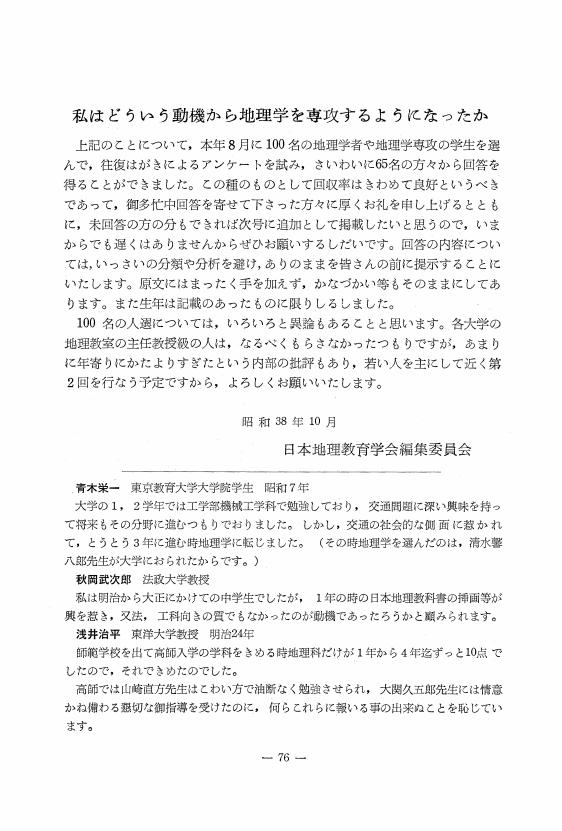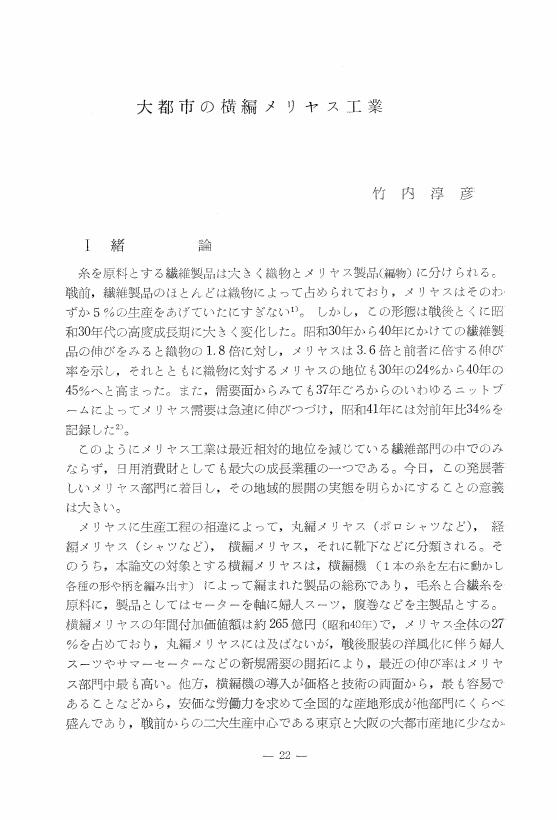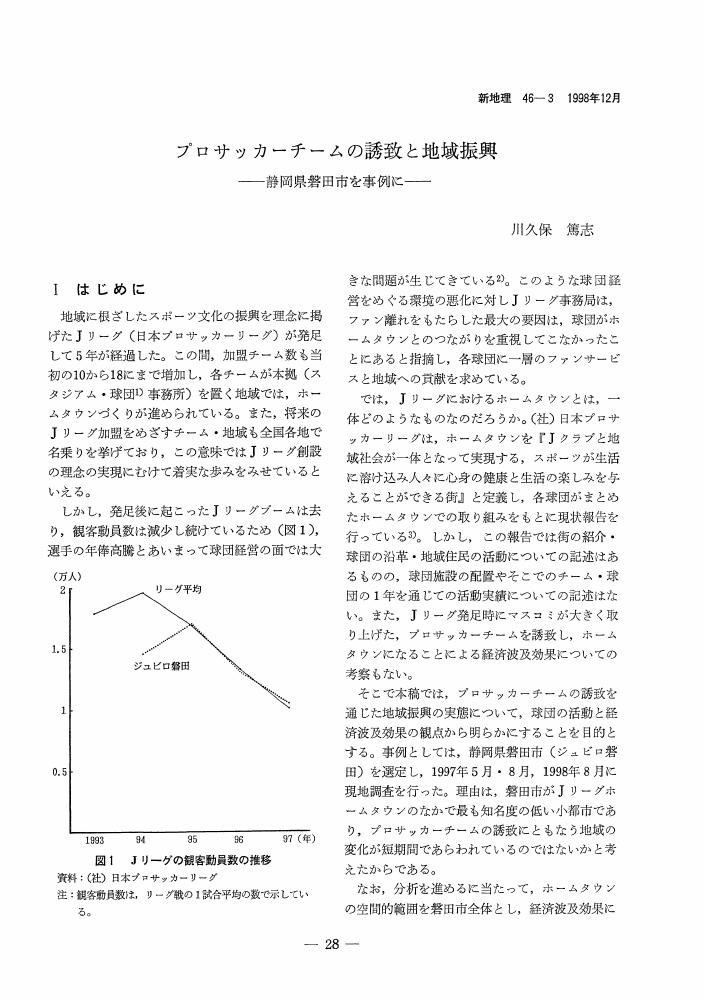3 0 0 0 OA 九十九里浜における観光開発と地域の変客
- 著者
- 関 信夫
- 出版者
- 日本地理教育学会
- 雑誌
- 新地理 (ISSN:05598362)
- 巻号頁・発行日
- vol.24, no.2, pp.13-42, 1976-09-25 (Released:2010-02-26)
- 参考文献数
- 28
3 0 0 0 OA わが国における郷土教育の系譜に関する研究
2 0 0 0 OA 私はどういう動機から地理学を専攻するようになったか
- 著者
- 日本地理教育学会編集委員会
- 出版者
- 日本地理教育学会
- 雑誌
- 新地理 (ISSN:05598362)
- 巻号頁・発行日
- vol.11, no.2, pp.76-86, 1963-09-25 (Released:2010-02-26)
2 0 0 0 OA 地形教育のための空撮全天球画像を用いた教材の開発と評価
2 0 0 0 OA 伊豆大島三原山観光乗馬業
- 著者
- 木山 高美
- 出版者
- 日本地理教育学会
- 雑誌
- 新地理 (ISSN:05598362)
- 巻号頁・発行日
- vol.23, no.1, pp.24-30, 1975-06-25 (Released:2010-02-26)
2 0 0 0 OA 地理教育における地域学習の位置 -子どもたちの地域学習体験からの逆照射-
- 著者
- 竹内 裕一
- 出版者
- 日本地理教育学会
- 雑誌
- 新地理 (ISSN:05598362)
- 巻号頁・発行日
- vol.67, no.1, pp.1-12, 2019 (Released:2020-02-05)
- 参考文献数
- 17
2 0 0 0 OA 中学生の世界認識の実態に関する研究
- 著者
- 蓮池 理之
- 出版者
- 日本地理教育学会
- 雑誌
- 新地理 (ISSN:05598362)
- 巻号頁・発行日
- vol.66, no.1, pp.20-37, 2018 (Released:2019-06-04)
- 参考文献数
- 16
2 0 0 0 OA 地理院地図を活用した水害リスクと持続可能な地域づくりを 考察する授業展開およびその効果
- 著者
- 髙橋 裕
- 出版者
- 日本地理教育学会
- 雑誌
- 新地理 (ISSN:05598362)
- 巻号頁・発行日
- vol.69, no.2, pp.69-81, 2021 (Released:2022-04-17)
- 参考文献数
- 13
2 0 0 0 OA 東アジア地域における国名・地名の特徴 高等学校地理学習への活用
- 著者
- 室谷 茂
- 出版者
- 日本地理教育学会
- 雑誌
- 新地理 (ISSN:05598362)
- 巻号頁・発行日
- vol.54, no.4, pp.1-18, 2007-03-25 (Released:2010-04-30)
- 参考文献数
- 51
2 0 0 0 OA 「生徒に提示するGIS教材」による地形図の読図支援 「大学入試問題演習」での利用事例
- 著者
- 伊藤 智章
- 出版者
- 日本地理教育学会
- 雑誌
- 新地理 (ISSN:05598362)
- 巻号頁・発行日
- vol.52, no.4, pp.32-43, 2005-03-25 (Released:2010-04-30)
- 参考文献数
- 7
- 被引用文献数
- 2 2
This report is a practice record of high school geography class with using GIS (Geographic Information System). Today, GIS does not become a popular tool in Japanese geography class. The reasons, the author points out, are two problems. First, many high school teachers think that GIS does not fit their geographical exercise for college examinations Second, a GIS software is not easy for students. When the teachers teach geography with GIS, they have to teach about software more about geographical subjects. The teachers who do not use GIS not so more tend to think that GIS is not useful tool for their classroom. The author tried to make a practice to solve these problems.The author showed students how to solve a “Center test”, or a simultaneously test for college entrance examination asked by public examination center, with a diagram which was drawn by GIS software, “Kashmir”. It is well known software among Japanese mountain lover. Not only processing digitalized topographical data, drawing a bird's view diagram for example, but also searching Japanese topographical map from an Internet service. The teacher could comment smoothly with showing online map and bird's view diagram. Students understood about how to solve the tests more.Today, we can get the map and data from an internet. But if students use the data with each own computer, it is very difficult to understand more. In this case, the teacher is just showing the diagram made by GIS. The author believes that the teachers have to use GIS more easily.
2 0 0 0 大正・昭和戦前期における自動車の普及過程
- 著者
- 奥井 正俊
- 出版者
- 日本地理教育学会
- 雑誌
- 新地理 (ISSN:05598362)
- 巻号頁・発行日
- vol.36, no.3, pp.30-38, 1988
- 被引用文献数
- 2
The present paper attempts to clarify the diffusion process of automobiles which had appeared on the Japanese road traffic as modern transport facility, during the <i>Taisho</i> and the pre-war <i>Showa</i> periods (1912-1937). Main findings are summarized as follows:<br>In Japan there were only 535 automobiles in 1912. The number of automobiles had gradually increased since then (Fig. 1). Particularly since automobiles showed great convenience at the reconstruction works just after the severe earthquake hitting the Kanto district in 1923, the number of automobiles had increased remarkably and counted 128, 735 at its maximum in 1937. Throughout the study period, most of automobiles were used for business, that is for both the bus enterprise and the trucking. Because prices of automobiles and their related costs exceeded the Japanese living standard in those days, private automobiles were very few. Also throughout the period, most of automobiles were imported articles from the Western countries, especialiy from the United States.<br>The number of automobiles per ten thousand population was calculated for each prefecture for the year's 1915, 1920, 1925, 1930 and 1935. Subsequently distribution maps were drawn (Fig. 3). On the whole automobiles spread from the most urbanized areas containing large cities, i. e. Tokyo, Kanagawa, Kyoto, Osaka and Hyogo prefectures to the urbanized areas and then to the rural areas. The propagation of automobiles on the nation-wide scale arrived latest at some of the Tohoku district and Hokkaido, where the propagation began over ten years later than Tokyo, the most advanced area. By using correlation analyses between such time lag variable and the selected explanatory variables, the author founds that areal variation of the time lag resulted from various industrial structures, road conditions and income level of areas and so on. Thus the author could be concluded that the automotive diffusion in those days described some parts in Japanese modernization process spatially and temporally.
2 0 0 0 OA フィヨルドの定義 デンマークのフィヨルドは含めなくてよいか
- 著者
- 籠瀬 良明
- 出版者
- 日本地理教育学会
- 雑誌
- 新地理 (ISSN:05598362)
- 巻号頁・発行日
- vol.26, no.3, pp.1-28, 1978-12-25 (Released:2010-02-26)
“Fjord are best developed on the coasts of British Columbia, southern Alaska, southern Chile, eastern Canada, Greenland, Norway, Iceland and Spitsbergen, the south-west of South Island (New Zealand); and finally Antarctica-Embleton & King (1968): Glacial and Periglacial Geomorphology p. 234”“fjord, or FIORD, long narrow arm of the sea, commonly extending far inland, that results from marine inundation of a glaciated valley. Many fjords are astonishingly deep-The New Encyclopaedia Britannica, 1968”There are 56 fjords in Denmark. The fjords in east-Jylland are the result of marine submergence of the deepest parts of the tunnel valleys, good examples are given by Vejle Fjord, Mariager Fjord. Sidinge fjord and Lamme fjord in Sjælland are central depressions under sea level. Maximum extent of the Stone Age Sea, and Ringkø bing Fjord, Nissum Fjord in west-Jylland are lagoons.
2 0 0 0 OA 南関東に於ける歳末市、正月市等の分布と構成
- 著者
- 中島 義一
- 出版者
- 日本地理教育学会
- 雑誌
- 新地理 (ISSN:05598362)
- 巻号頁・発行日
- vol.4, no.1, pp.32-39, 1955-06-25 (Released:2010-08-10)
2 0 0 0 OA 寺院過去帳よりみた天保の飢饉 (中間報告)
- 著者
- 菊池 万雄
- 出版者
- 日本地理教育学会
- 雑誌
- 新地理 (ISSN:05598362)
- 巻号頁・発行日
- vol.20, no.3, pp.1-23, 1972-12-25 (Released:2010-02-26)
The famine disasters attacked the Northeast Japan partly including the Central Japan in the late Shogunate (1750s, 1780s, 1830s, and 1860s).The writer investigates the number of victims who starbed to death in those lean years and other problems through “kakocho” of several temples, and concludes as follows:1) The famine disasters in 1830s showed the widest suffered areas, it included the whole areas of the Northeast and the Central Japan.2) The core area suffered from the starbation almost accord with Dfa, the climatic pattern of Köppen.3) The rural areas suffered much more from starbation than urban areas.4) Common people of urban areas suffered more from starbation Samurai people.5) More adult men died than children in all starbed districts.
2 0 0 0 OA 大都市の横編メリヤス工業
- 著者
- 竹内 淳彦
- 出版者
- 日本地理教育学会
- 雑誌
- 新地理 (ISSN:05598362)
- 巻号頁・発行日
- vol.16, no.2, pp.22-34, 1968-09-25 (Released:2010-02-26)
2 0 0 0 OA プロサッカーチームの誘致と地域振興
- 著者
- 川久保 篤志
- 出版者
- 日本地理教育学会
- 雑誌
- 新地理 (ISSN:05598362)
- 巻号頁・発行日
- vol.46, no.3, pp.28-39, 1998-12-25 (Released:2010-04-30)
2 0 0 0 OA 越後, 三条金物工業の地域形成
- 著者
- 土田 邦彦
- 出版者
- 日本地理教育学会
- 雑誌
- 新地理 (ISSN:05598362)
- 巻号頁・発行日
- vol.19, no.2, pp.15-38, 1971-09-25 (Released:2010-02-26)
- 被引用文献数
- 1
The writer shows in this paper the stages of development foundry industry of Sanjo: (1) The foundry dependent on handicraft of the farmer's side job. (2) Emergence of the foundry craftsman as a specialist. (3) The first stage of the foundry under the control of the wholesale merchants. (4) The second stage of the foundry under the control of the wholesale merchant. (5) The modernized and concentrated foundry.In the developing stage of the Shogunate Era the foundry craftsmen obtained their materials of products from the wholesale merchants and the deal of their products were under the control of the wholesale merchants. Afterwards the wholesale merchants gave craftsmen the fund to obtain materials. The production and dealing system changed gradually, but remarkable change came after the 2nd World War. The control of the wholesale merchants quickly disappeared since then, and modernized factories were built. Concentration of the factories was the new trend.In spite of modernization, the foundry industry of Sanjo are all the small scale one in both capital and factory even today. The kinds of products which are produced in the different factories are very various and each amount of products is not much. In addition the technical process still depends mainly upon handicraft, most of them are combined each other through various kinds of technical processes. It is one of the reasons why concentration are promoted.
2 0 0 0 OA 諏訪地方における地域文化の地理学的考察
- 著者
- 伊藤 文夫
- 出版者
- 日本地理教育学会
- 雑誌
- 新地理 (ISSN:05598362)
- 巻号頁・発行日
- vol.35, no.1, pp.29-40, 1987-06-25 (Released:2010-04-30)
- 参考文献数
- 22
The author intend to consider the characteristics of the local culture in Suwa area from the viewpoints of analyzing Minka (the residences of farmers), traditional events and vegetables in the cold highland.The results of this study are summarized as follows;(1) The climatic characteristics of Suwa area are severe coldness and strong wind in winter because it locates in the cold highland. For these reasons, there are many ideas such as Yukigaki (taxaceous tree fences for windbreak) and Nurume (a ditch for paddy rice fields to warm up irrigational water) to prevent its coldness everywhere in this area. On the other hand, there many localized industries such as producing Kanten (agar-agar) and Kori-tofu and -mochi (frozen and dried tofu and glutinous rice cake) which exploit severe coldness. These industries are developed in the settlements of the upland and of the eastern foot of the mountain slopes where the sun sets very early in the evening.(2) There are some more landscapes peculiar to cold climate like this Suwa area. The structures such as Tategurumi (the way of building Minka: the storehouse is built in the main building), Teppei-seki yane (tiles of the roofs are made of plates of (two-pyroxene-andesite) and Ohnoki-zukuri (the building with long eaves) are rational ways of building the Minka under the climate like Suwa area. Traditional vegetables such as Ueno-daikon (a kind of radish) and Suwa-benikabu (a kind of turnip) have been cropped for making pickles with cold resistance to cross over winter. Traditional festivals and events associated with Suwa-Shinko (the faith in the Suwa Shrine) penetrate into the people's life of this area.(3) It is recognized that are four types of settlements which preserve traditional cultures very well in this area. The first type of the settlements are located in the foot of high mountains; Sasahara and Kami-Tsukinoki, Chino City and Ueno, Suwa City. The second type are located far from the main road; Kami-Futta and Ohsawa, Chino City and Sendatsu, Fujimi Town. The third ones have common forest owned by Zaisan-ku or Buraku-ku (small terrestrial groups); Toyoda, Konan and Shiga, Suwa City, Higashi-Yamada, Shimo-Suwa Town, Oikawa and Misawa, Okaya City, Miyagawa and Tamagawa, Chino City and Okkoto, Fujimi Town. The fourth type of the settlements have the priginal hot spring; Kowata, Suwa City. Peoples in the settlements of last two types have strong solidarity of a rural community to take over their cultures because the groups have comonm properties.The Suwa Culture tends to flow into the Kami-Ina area, where belongs the same drainage of Suwa Lake and Tenryu River. Hewever, it is hard to flow into Yamanashi Prefecture.
2 0 0 0 OA 会長講演
- 著者
- 山口 幸男
- 出版者
- 日本地理教育学会
- 雑誌
- 新地理 (ISSN:05598362)
- 巻号頁・発行日
- vol.52, no.3, pp.56-64, 2004-12-25 (Released:2010-04-30)
- 参考文献数
- 8












